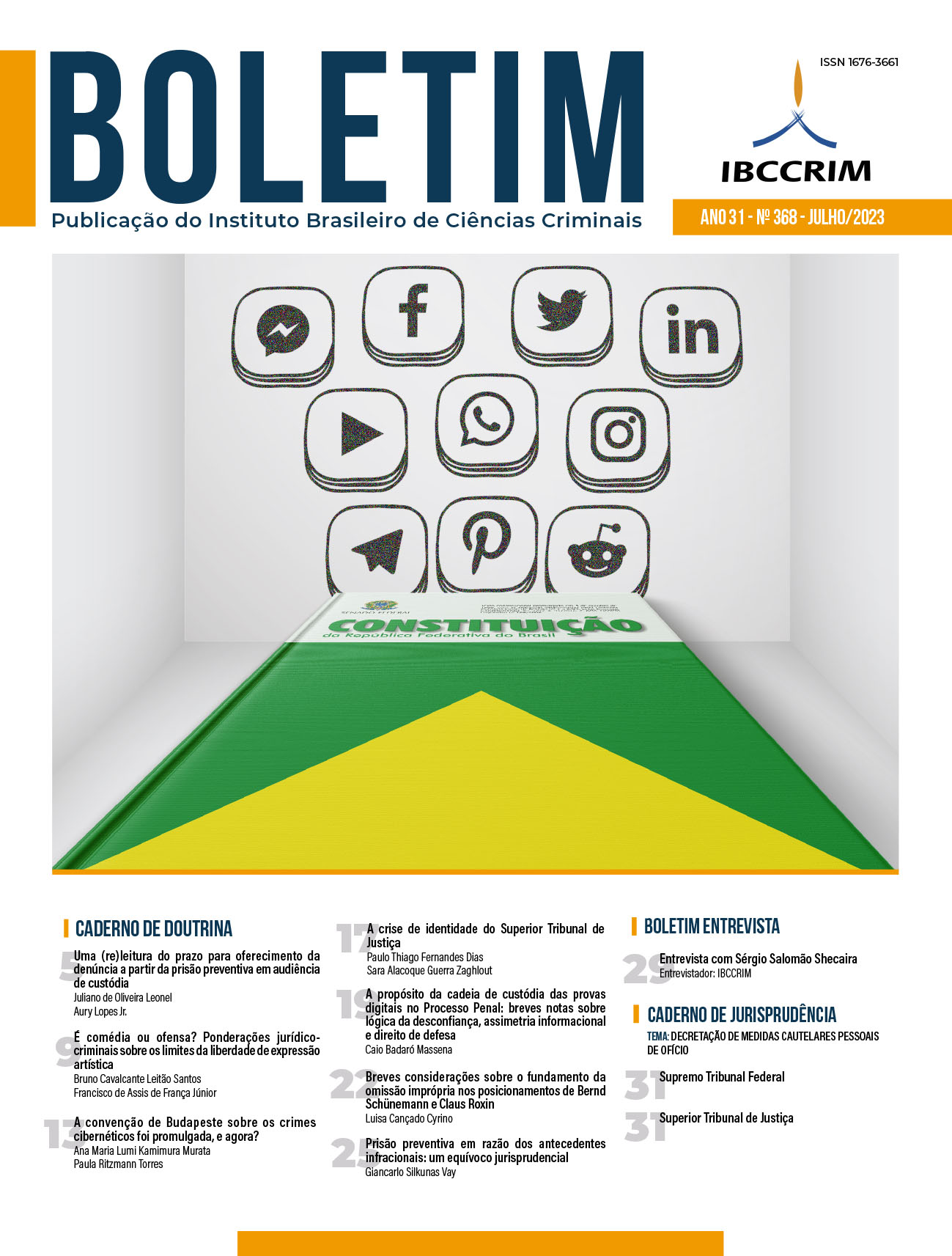The Budapest Convention on Cybercrimes was enacted, what now?
Views: 2484Keywords:
Budapest Convention, cybercrimes, criminal liability of the legal entity, International legal cooperationAbstract
With the enactment of the Cybercrime Convention (Decree 11,491/2023), Brazil assumed new international obligations in the fight against cybercrime. The article focuses on three criminal and procedural aspects of the Convention (typification of cybercrimes, criminal liability of legal entities, and international legal cooperation for obtaining digital evidence), which, due to their innovative nature, demand reflection on the measures to be adopted by the State for its implementation and compatibility with the Brazilian legal system.
Downloads
Publication Facts
Reviewer profiles N/A
Author statements
- Academic society
- Instituto Brasileiro de Ciências Criminais
- Publisher
- IBCCRIM
References
BADARÓ, Gustavo. Os standards metodológicos de produção na prova digital e a importância da cadeia de custódia. Boletim IBCCRIM, ano 29, n. 343, p. 7-9, jun. 2021. Disponível em: https://ibccrim.org.br/publicacoes/edicoes/747/8544. Acesso em: 30 maio 2023.
CARVALHO RAMOS, André de. Curso de Direito Internacional Privado. 3. ed. São Paulo: Saraiva, 2023.
COUNCIL OF EUROPE. Convention on cybercrime: Special edition dedicated to the drafters of the Convention (1997-2001). Estrasburgo: Council of Europe, 2021a. Disponível em: https://rm.coe.int/special-edition-budapest-convention-en-2022/1680a6992e. Acesso em: 14 maio 2023.
COUNCIL OF EUROPE. Second additional protocol to the Convention on Cybercrime on enhanced co-operation and disclosure of electronic evidence. Estrasburgo: Council of Europe, 2021b. Disponível em: https://rm.coe.int/special-edition-second-protocol-en-2021/1680a69930. Acesso em: 14 maio 2023.
COUNCIL OF EUROPE. T-CY Guidance Note # 3 Transborder access to data (Article 32) Adopted by the 12th Plenary of the T-CY (2-3 December 2014). Disponível em: https://rm.coe.int/CoERMPublicCommonSearchServices/DisplayDCTMContent?documentId=09000016802e726a. Acesso em: 30 maio 2023.
COUNCIL OF EUROPE. Reservations and Declarations for Treaty No.185 – Convention on Cybercrime (ETS No. 185). 10 out. 2006. Disponível em: https://www.coe.int/en/web/conventions/full-list?module=declarations-by-treaty&numSte=185&codeNature=0. Acesso em: 30 maio 2023.
DASKAL, Jennifer. The un-territoriality of data. The Yale Law Journal, v. 125, n. 2, p. 326-398, 2015. Disponível em: https://www.yalelawjournal.org/article/the-un-territoriality-of-data. Acesso em: 30 maio 2023.
GALVÃO, Fernando. Teoria do crime da pessoa jurídica: proposta de alteração do PSL nº 236/12. Belo Horizonte: D’Plácido, 2020.
JESUS, Damásio de; MILAGRE, José Antonio. Manual de crimes informáticos. São Paulo: Saraiva, 2016.
LIGETI, Katalin; VERVAELE, John; KLIP, André. Preventing and resolving conflicts of jurisdiction in EU Criminal Law. Oxford: Oxford University Press, 2018, p. 182-183.
NOJEIM, Greg. Reforma do sistema MLAT entre privacidade e eficiência: os dilemas do acesso transnacional a dados de usuários. Tradução: Ana Luiza Araujo. In: ANTONIALLI, Dennys; ABREU, Jacqueline de Souza (Orgs.). Direitos fundamentais e processo penal na era digital: Doutrina e prática em debate. Vol. I. São Paulo: InternetLab, 2018. pp. 176-200.
RITZMANN TORRES, Paula. Desafios contemporâneos do direito à prova: obtenção de dados digitais armazenados no exterior. Revista da Faculdade de Direito da Universidade Federal de Uberlândia, v. 50, n. 1, p. 229-252, 2022. https://doi.org/10.14393/RFADIR-50.1.2022.65264.229-252
SALVADOR NETTO, Alamiro Velludo. Responsabilidade penal da pessoa jurídica. 2. ed. rev., atual. e ampl. São Paulo: Thomson Reuters Brasil, 2020.
SYDOW, Spencer Toth. Curso de Direito Penal Informático. 3. ed. Salvador: JusPodivm, 2022.
Downloads
Published
How to Cite
Issue
Section
License
Copyright of published articles belongs to the author, but with journal rights over the first publication and respecting the one-year exclusivity period. Authors may only use the same results in other publications by clearly indicating this journal as the medium of the original publication. If there is no such indication, it will be considered a situation of self-plagiarism.
Therefore, the reproduction, total or partial, of the articles published here is subject to the express mention of the origin of its publication in this journal, citing the volume and number of this publication. For legal purposes, the source of the original publication must be consigned, in addition to the DOI link for cross-reference (if any).


 Português (Brasil)
Português (Brasil)
 English
English
 Español (España)
Español (España)










